By Gilles Desorbay
This article gives a brief overview of how the chemical industry impacts all of us, looking at some of the chemical products we use in our daily lives, the economic contribution of this industry to the world economy and sustainability issues. A brief analysis of the impact of COVID-19 on the industry is also included.
The chemical industry is a transformation industry of mostly crude oil, natural gas, salt or coal and a primary enabler of modern living, converting these natural occurring feedstocks into both industrial and consumer goods while creating along the way revenues and jobs in various value chains around the globe.
Chemical products are omnipresent in modern life. From energy-efficient homes and more comfortable furniture and bedding to smoother skin creams, affordable clothing, packaging that protect food items and longer-lasting paints, chemical products play a vital role at every moment of our daily life. The multitude of chemical products includes plastics (various families of polymers), synthetic rubbers, solvents, paints, inks, coatings and caulks, detergents, fertilizers, man-made fibres, cosmetics and perfumes.
From the moment we wake up in the morning, turning off the alarm on the nightstand (plastic casing, coatings), leaving the comfort of our soft bed (mattress, bedding with a mix of natural and man-made fibres), to the early morning shower (shampoo, shower gel: products and packaging) and a stop in the kitchen for breakfast (kitchen appliances, plastic containers to protect food, milk and juice bottles), we can rarely avoid the use of these ubiquitous chemical products. The reason is that plastics, and more broadly chemical products, do bring sought-after attributes such as protection, barrier, strength, resistance, lightweight, moldability or durability.
Continuing with our daily routine, we take a car or public transport (steering wheel, tyres, door liners, engine components, seat belts, airbags) to go to work. Later at the office (desks, chairs, IT equipment), we order a fresh bowl of salad for lunch (packaging) before heading out for personal activities, be it watching a movie (TV, remote control, couch), exercising (helmet, rackets, balls) or tackling the latest home improvement projects (tools, weed killer, paints).
The increased presence of plastic packaging over the past few decades in our kitchens, for instance, can be illustrated with the 2 following pictures: Beyond the current use of chemicals, the mega-trends impacting the world today, including population growth, population ageing and urbanization have a direct impact on the use of petrochemical products. To adjust to these trends, the world will indeed need for instance more water and energy supply (hence more pipes, insulators, solar panels,wind turbines,et.al.), more infrastructure (building materials, pipes, cables, et.al.), more medical services and products (hospital beds, linens, syringes, pouches, medicines, …) and more food (fertilizers, packaging). Each leading to increasing demand for chemicals, as illustrated below:
Beyond the current use of chemicals, the mega-trends impacting the world today, including population growth, population ageing and urbanization have a direct impact on the use of petrochemical products. To adjust to these trends, the world will indeed need for instance more water and energy supply (hence more pipes, insulators, solar panels,wind turbines,et.al.), more infrastructure (building materials, pipes, cables, et.al.), more medical services and products (hospital beds, linens, syringes, pouches, medicines, …) and more food (fertilizers, packaging). Each leading to increasing demand for chemicals, as illustrated below:
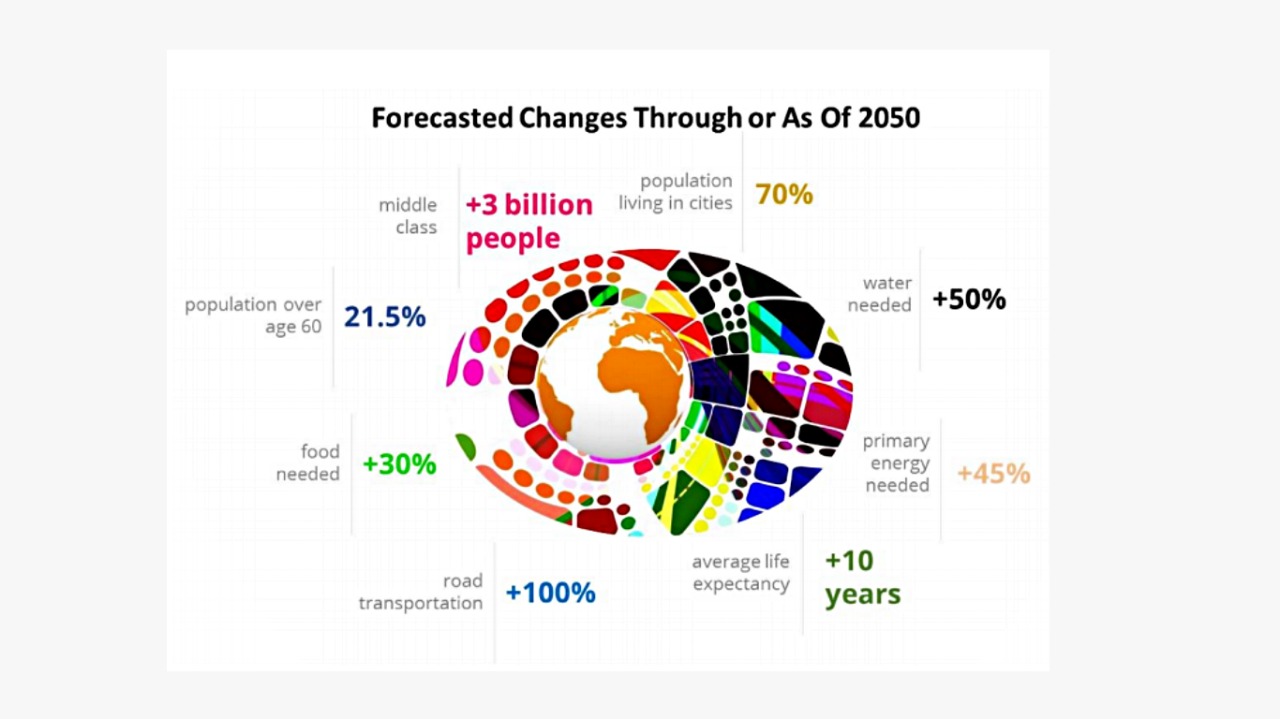
After having rapidly discussed above the critical and growing impact of chemical products in our daily lives, let’s now look at how this industry impacts the economy and job markets.
Let’s first define the chemical industry as per OXFORD ECONOMICS:
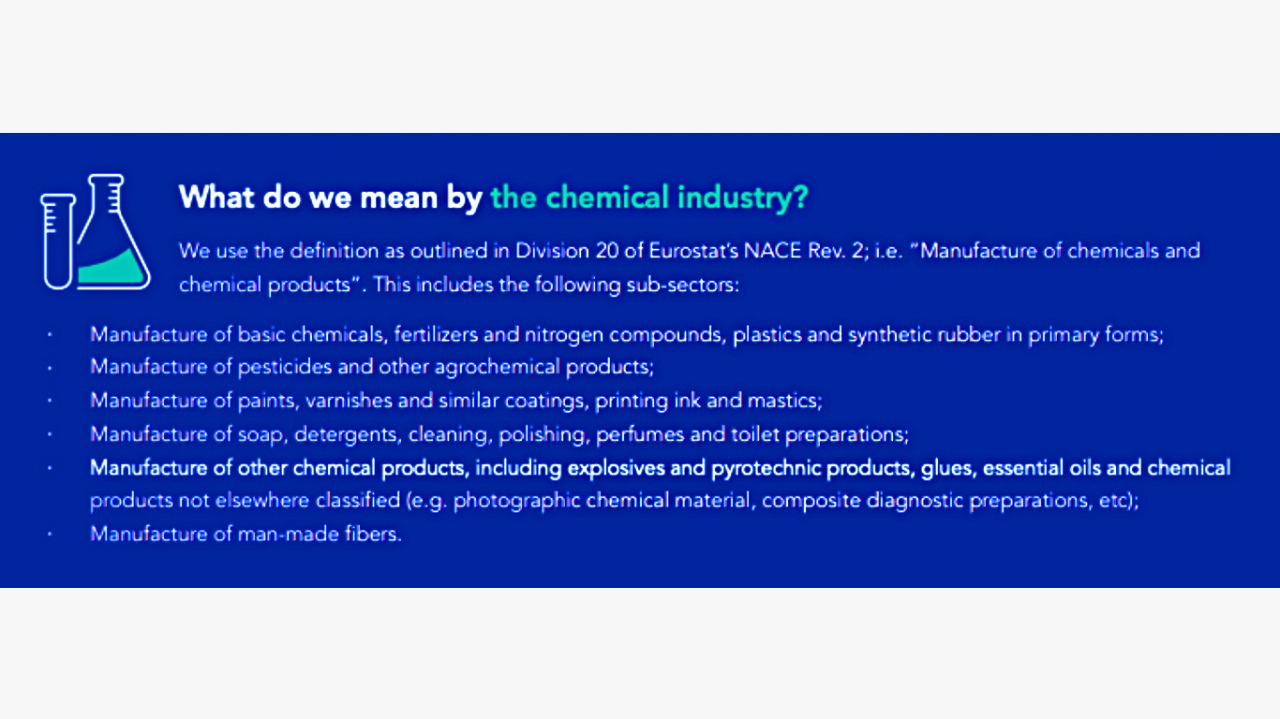
The chemical industry has been an integral part of the global economic landscape for many centuries. The first chemical plants were built in Europe during the industrial revolution when chemical processes for making concrete and waterproof clothing were devised. Since then, the industry has evolved to become a bastion of productivity that permeates through nearly every good-producing sector. Today, the chemical industry plays a crucial role in regional economies in every corner of the world, and in most sectors of those economies.
Let’s quantify the impact of the chemical industry on the world economy through a couple of key figures and graphs.
In 2017, according to Cefic and Oxford Economics, the chemical industry globally contributed:
| DIRECT IMPACT | DIRECT + INDIRECT + INDUCED IMPACT | |
| Gross value added | 1.1 trillion = 1.4% of world GDP | $5.7 trillion = 7.1% of world GDP |
| Employment | 15 million jobs | 120 million |
The $5.7 trillion of value added to world GDP is equivalent to the combined annual GDPs of India, Brazil and Mexico.
A regional break-up of this total contribution of $5.7 trillion and 120 million jobs is summarized in the figure below
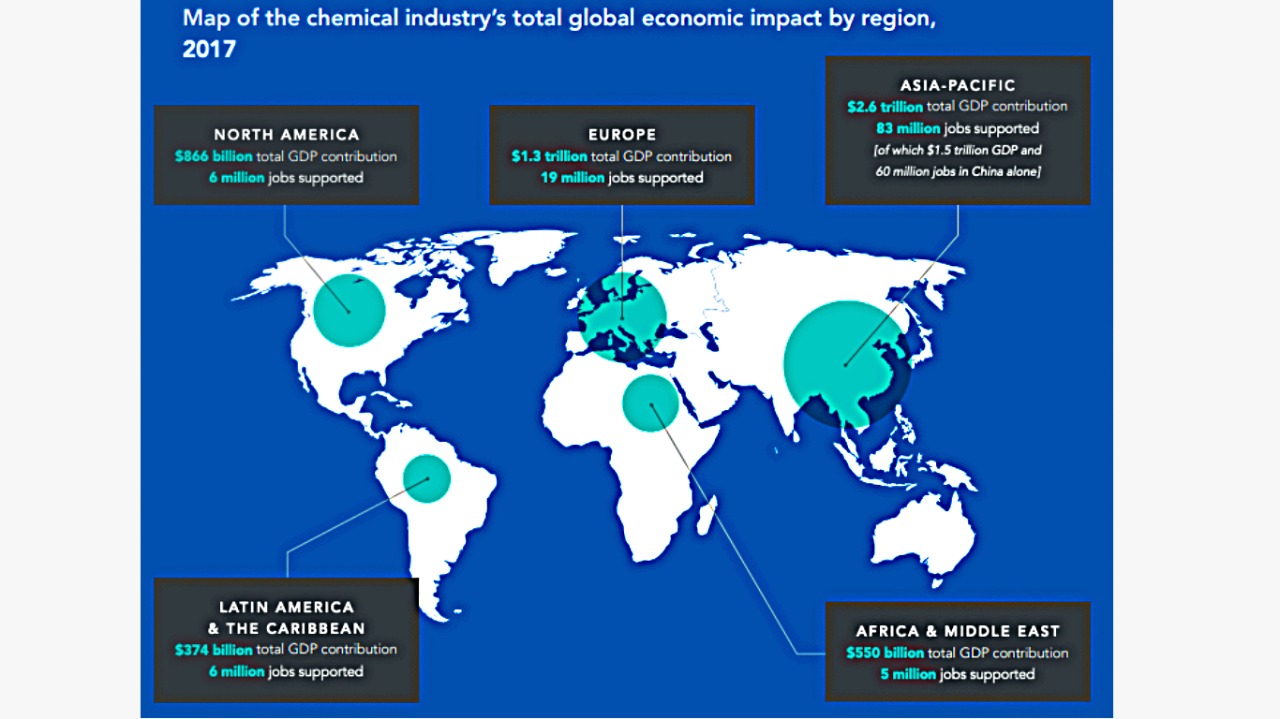
Worldwide chemical sales reached $3.4 trillion in 2018 and capital spending $193 billion, with the following regional breakdown

 These 2 graphs above not only show the leading role of China and the rest of Asia but also the critical weights of Europe and the Americas, in both current sales and recent capital spending.
These 2 graphs above not only show the leading role of China and the rest of Asia but also the critical weights of Europe and the Americas, in both current sales and recent capital spending.
The chemical industry is a truly global industry:
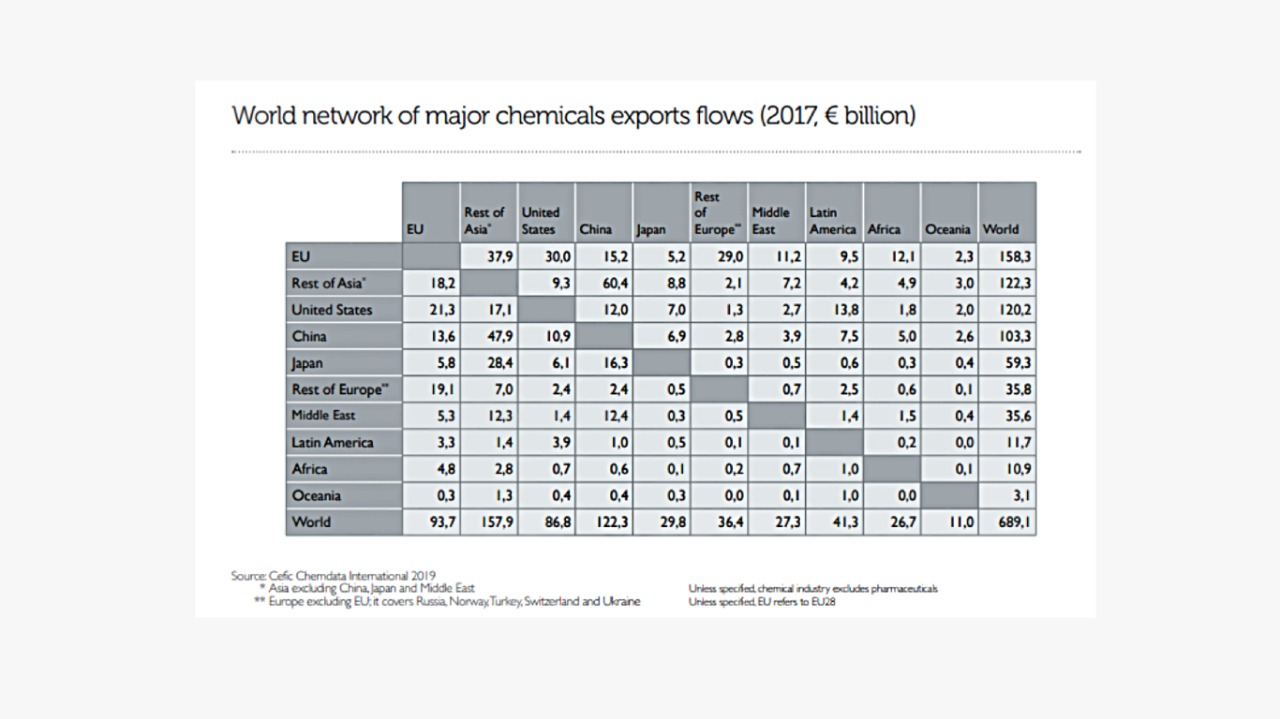
The industry also continues to contribute to international research and development across the world. With an increase of more than 60% of global Research and Investment spending between 2008 and 2018, China is now the largest contributor with 27% of global R&I spending, as shown below
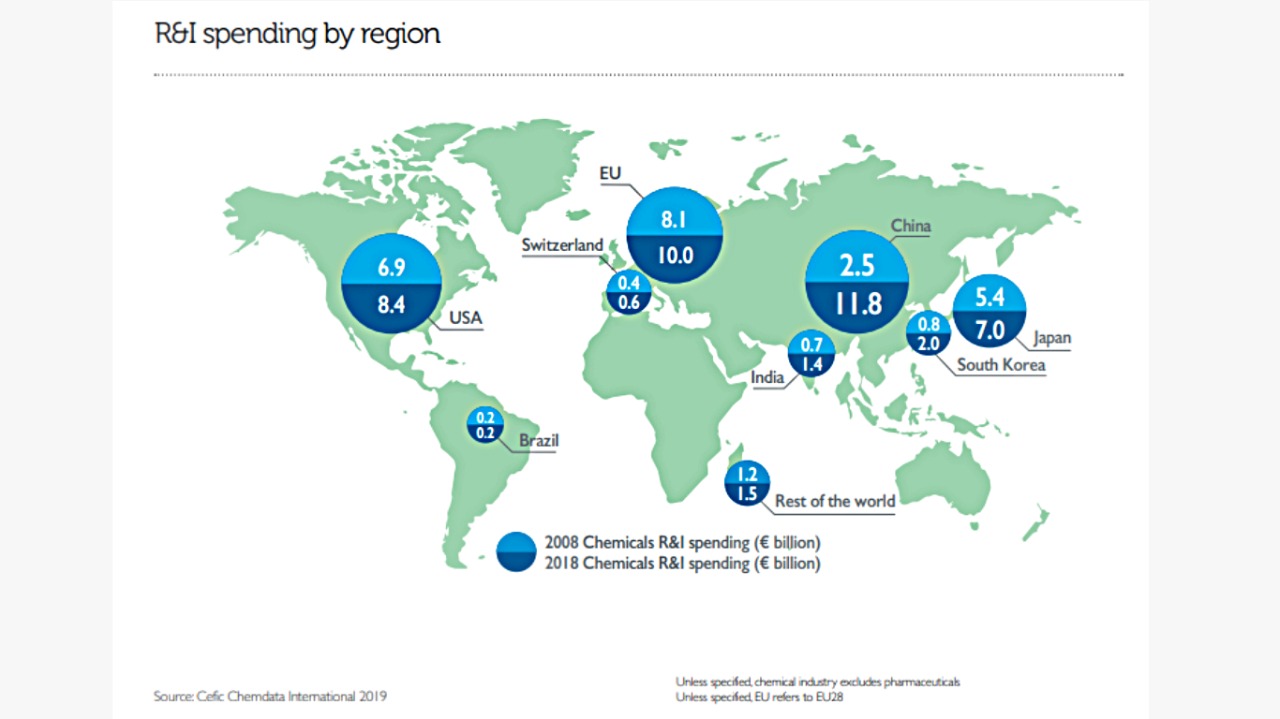
Now that we have established the omnipresence of chemical products in our daily lives and the critical importance of the chemical industry to the global economy, let’s look at some the threats and pressures known to the industry.
The chemical industry has been, in a way, the victim of its own success and becomes a noticeable contributor to various aspects of global pollution: Consumer pressure and new legislation around the world are pushing the industry to step up its offer and address their environmental demands, focus part of its R&I spending and integrate the concepts of sustainability and circular economy in the design of its products, technologies and feedstock.
Consumer pressure and new legislation around the world are pushing the industry to step up its offer and address their environmental demands, focus part of its R&I spending and integrate the concepts of sustainability and circular economy in the design of its products, technologies and feedstock.
The industry is actually central to achieving the global targets expressed in many of the United Nations 17 Sustainable Development Goals (SDGs). The industry already produces a huge range of finished products for general consumption, including:
- fertilizers, pesticides, and other agrochemical products that play a crucial role in feeding a growing global population
- LED lighting which results in substantial power savings and
- roof and window coatings used to improve insulation levels as part of climate change mitigation efforts.
- The industry also produces key inputs, and enables processes, for other manufacturing activities that benefit living standards and consumers around the world. These include
- water chemistry, enabling the treatment, delivery, and conservation of clean drinking water that is critical to a number of SDGs
- plastics used for packaging, which plays a major role in protecting fresh, processed and prepared food, extending its shelf life and
- man-made fibres, such as nylon and polyester
In addition to these products and processes, the chemical industry is committed to the sound management of chemical substances––as encapsulated by the adoption of the Strategic Approach to International Chemicals Management (SAICM) in 2006. Sound management of chemical substances represents another way in which the industry is contributing to sustainable development around the world. Moreover, through “circular” initiatives, the chemical sector can more effectively recycle and reuse molecules to produce consumable products, while reducing waste and creating new value to society.
In simple words, the chemical industry has been part of the pollution and sustainability problems and is also, around the world an active part of the solution.
The coronavirus outbreak continues to squeeze the global economy and, with it, chemical companies. The pandemic will impact the chemical industry through overall decreased demand for its products, disturbance of its supply chains, potentially tightening credit markets and the health of its workforce. Chemical companies, like many other manufacturers, are exposed on multiple fronts to the disruption brought by the COVID-19 outbreak. Small pockets of the industry may benefit – such as those producing sanitation products and plastics for medical devices – but the vast majority will be negatively impacted. It may force chemical companies to possibly reconsider their existing supply chains and improve their transparency, find alternatives to China-based suppliers, evaluate automation solutions in their plants, detail new plans and disclosures about risks, keep an open and regular dialogue with suppliers, customers and authorities to seek alternatives and co-create new solutions andre visit their divestment and investment plans
Sections of the chemical industry likely to be more impacted include those serving the apparel, automotive, consumer durable and non-food retail. While the least impacted part of the industry will likely be companies focusing on segments including food and beverage packaging, pharmaceuticals or agriculture.
If you wish to update some of your plans and discuss how LR Consultants can assist you, please contact us at info@lr-consultants.com

